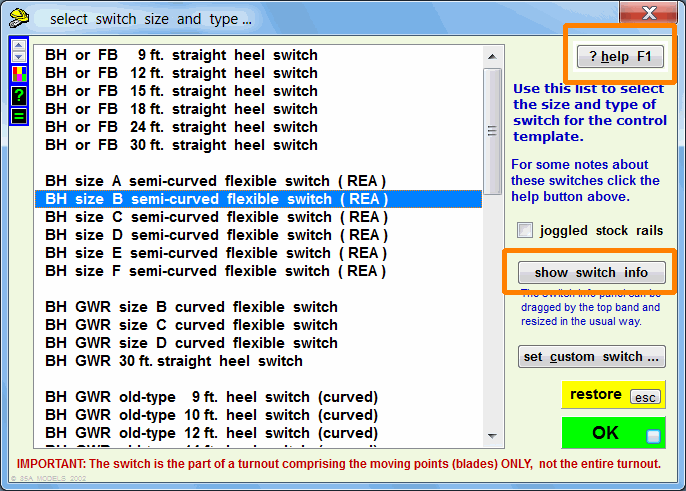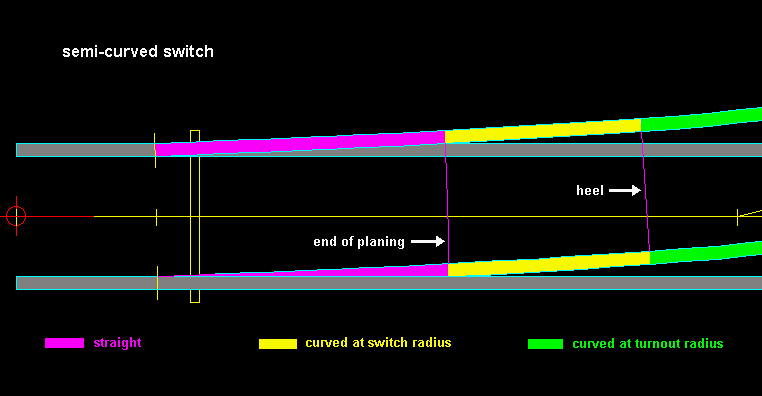Templot Club Archive 2007-2020
|
|||
| author | remove search highlighting | ||
|---|---|---|---|
|
posted: 17 Mar 2012 19:41 from: jeffthom
click the date to link to this post click member name to view archived images |
Hello All, I'm a new subscriber to Templot. I'm also stunned (gobsmacked?) by the capabilities of Templot. I realize that it is not designed as a general track planning tool, yet it serves that function as well as any I have seen and better than most. We have all seen elegant prototype track scenes where a lot of what we in the US would call 'special trackwork' is employed make the tracks, yards, sidings (loops?) flow organically into the geology of the site. I have one site in mind from up near the defunct Pennsylvania RR 'town' of Renovo, PA. My hunting camp is nearby and every time I go there I have to go up an old pipeline service road to a hilltop where I can see this trackage. However, it's full of curved track switches and crossing diamonds, one of which contains two different curves. I think that Templot is the only way I could possibly layout a version of this prototype trackage. My thanks for this wonderful tool. I'll look forward eagerly to working with the 9mm-type modelers in devising jigs to construct this kind of work. Finally, to the point; I am woefully ignorant of track standards. Templot tables and examples seem full of railroad-specific track standards - perhaps from the old British Rail Companies of the Glory Years - Great Western, etc. - I have no idea. Is there an 'idiot's guide' to the standards referred to in Templot? What is a B-4 to P6 rail? In the US I wasn't aware that standard gage track work varied at all across railroad companies. I'm told I'm quite wrong about that, and I will check for recorded standards. Are there North American standards now incorporated into the Templot generic libraries of N-Scale (9-mm) or HO Scale (1:67) track switches? Thank you all in advance for your help. I'll be quiet until having read the referenced documents. Jeff Thompson Florida - flatland railroading! |
||
|
posted: 17 Mar 2012 23:11 from: Tony W
click the date to link to this post click member name to view archived images |
Hello Jeff. I am not really up on US track and how it is specified. UK track specifies the Crossing and Switch angles by offsets. For instance a 1 in 6 crossing will widen 1 unit for every 6 units distance from the crossing nose. Switch blades are similar but use letters A to F or G for predefined angles. On the heading page (go back one) take a look under the Templot Companion box to the bottom right of the screen and select Real Track for more information. Tony. |
||
| Last edited on 17 Mar 2012 23:13 by Tony W |
|||
|
posted: 18 Mar 2012 21:09 from: jeffthom
click the date to link to this post click member name to view archived images |
Thank you for the reply Tony. I followed your reference - good stuff. Also found a large thread on Wikipedia for track work. Google for Bullhead Track and the Wiki citation will be in the top few. It discusses mostly N.American practice but is informative none the less. I have found nothing yet on the British letter scheme (A - F) of denoting switch point length. I presume this relates to concerns over long, fragile point ends. Do you know of a handy standard or reference? The Wiki also discusses the 'thick web' point rail stock to avoid the weakness of simple planed rail points. It even shows an example from a RR in Ohio. Is all British steam power so pretty??! Thanks, Jeff |
||
|
posted: 18 Mar 2012 21:17 from: stuart1600
click the date to link to this post click member name to view archived images |
jeffthom wrote:Hi Jeff, I seem to recall some details of switch types and their lengths on the Templot Companion site, in the section on "Real Track" I think. Probably worth a look, if it's not there then it's somewhere else amongst the many Templot resources - I'm pretty sure I haven't dreamt it Happy modelling. Stuart |
||
|
posted: 18 Mar 2012 21:44 from: Martin Wynne
click the date to link to this post click member name to view archived images |
jeffthom wrote:I have found nothing yet on the British letter scheme (A - F) of denoting switch point length. I presume this relates to concerns over long, fragile point ends. Do you know of a handy standard or reference?Hi Jeff, All the data is in Templot. Go to template > switch settings... menu item. Make sure to read the red note at the bottom of the dialog: 2_181636_260000000.png  Click the ? help F1 button for some general notes about different switches. Select a switch in the list and click the show switch info button to see the actual dimensions. A is the shortest (1:24 deflection angle). F is the longest (1:80 deflection angle): semcu_sw.gif  More info: http://www.templot.com/martweb/gs_realtrack.htm#switch_types Lots of technical stuff: http://www.scalefour.org/resources/gwrtracknotes1.html http://www.scalefour.org/resources/gwrtracknotes2.html regards, Martin. |
||
|
posted: 18 Mar 2012 23:12 from: Ian Allen
click the date to link to this post click member name to view archived images |
Welcome to Templot. There is also useful information here... http://www.gauge0guild.com/newmanual5.asp Lots of reference to prototypes, as well as detailed tables on different crossing Vee and switch dimensions, albeit for O gauge (7mm/foot). As to your other question, aesthetically pleasing rather than pretty I'd say ;-) Ian |
||
|
posted: 19 Mar 2012 00:13 from: Tony W
click the date to link to this post click member name to view archived images |
Hi Jeff / Stuart. The technical bit on Switch blades IS under Real Track, but is under the MISC link. You have to scroll down a bit to find it though. Tony. |
||
|
posted: 19 Mar 2012 17:18 from: jeffthom
click the date to link to this post click member name to view archived images |
Hi Tony, Got it, thanks. So much info, so many places! LOL... Thanks to all who were so kind as to send along pointers. Jeff |
||
|
posted: 20 Mar 2012 15:56 from: Tony W
click the date to link to this post click member name to view archived images |
jeffthom wrote:So much info, so many places! LOL... Thanks to all who were so kind as to send along pointers.Hi Jeff. Indeed. These links have provided a lot of useful new info for me as well, although the O gauge links seem to only work if you sign in as a member. So very useful. Thanks for asking the question. Tony. |
||
|
posted: 20 Mar 2012 17:25 from: jeffthom
click the date to link to this post click member name to view archived images |
Hi Tony, I am getting very tempted to create a shelf-based little brookside switching junction layout in something around S or O gage just to display the modeling that can be done at those scales. The stock rail jog in N-scale amounts to only 0.003" Sheese. Perhaps a British country scene so I can model those 'more attractive' traditions of motive power dress. Something like smallish 0-4-2T or 0-4-4T power and 1930's goods wagons, gondola cars and a small passenger or mixed use car. Of course that brook would be the engine's water source while the driver takes a pipe under the apple tree. We hear the thudding of a small steam pump and the odd safety venting of steam. Perhaps some railfans have brought along a picnic lunch while the brakeman hovers with one hand on hip and watch in the other... Must begin looking for good period references! Also nomenclature - LOL! You may yet hear more silly questions from me. Jeff. |
||
|
posted: 20 Mar 2012 19:06 from: Nigel Brown click the date to link to this post click member name to view archived images |
Hi Jeff Looks like you're thinking of a British equivalent of a rural American short line. You might find some ideas in the light railways run by one Colonel Stephens. Here's a couple of links:- http://www.colonelstephenssociety.co.uk/home.html http://www.hfstephens-museum.org.uk/ Cheers Nigel |
||
|
posted: 20 Mar 2012 20:42 from: Nicholas Geti
click the date to link to this post click member name to view archived images |
I am getting two of every message on this board. How do I stop that? | ||
|
posted: 20 Mar 2012 20:53 from: Martin Wynne
click the date to link to this post click member name to view archived images |
Nicholas Geti wrote: I am getting two of every message on this board. How do I stop that?Hi Nicholas, You had set up to receive emails direct from this board, AND via the Templot group on Yahoo. I have changed your Yahoo setting to "No Email" for you. If that is not what you wanted, please go to: http://groups.yahoo.com/group/templot/join and change it back. regards, Martin. p.s. it would have been better to start a fresh topic, rather than interrupt Jeff's topic with this. |
||
|
posted: 20 Mar 2012 21:39 from: Nicholas Geti
click the date to link to this post click member name to view archived images |
Thank you. What is strange is that I only noticed it in the past couple of weeks. It is unfortunate that you had to spend your valuable time dealing with this trivial problem. |
||
|
posted: 20 Mar 2012 21:52 from: jeffthom
click the date to link to this post click member name to view archived images |
Hi Nigel, Thank you for the references. Huge introduction. I daresay that the Colonel would have been absolutely fascinating to share a pint - or two - with. The words are often the same here in the 'States - sold, scrapped, rotted, lifted, footpath, car park... Very sad. Good modeling, my compatriot! Jeff |
||
| Please read this important note about copyright: Unless stated otherwise, all the files submitted to this web site are copyright and the property of the respective contributor. You are welcome to use them for your own personal non-commercial purposes, and in your messages on this web site. If you want to publish any of this material elsewhere or use it commercially, you must first obtain the owner's permission to do so. |